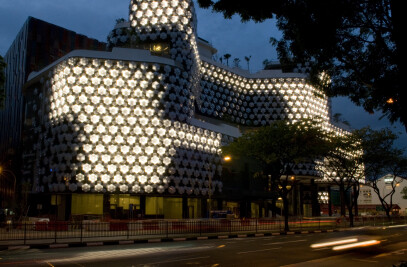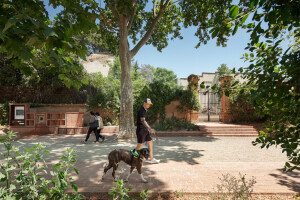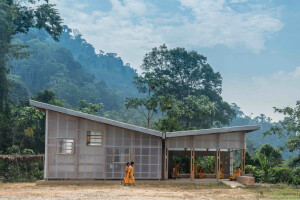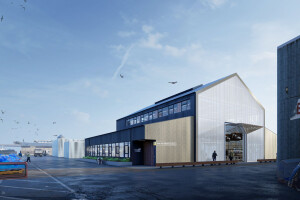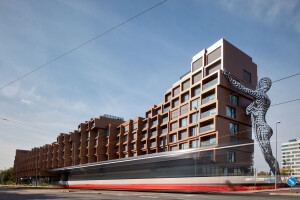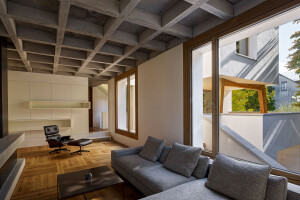The idea of the media installation BIX arose out of considerations on how to equip the interior of the Kunsthaus in Graz with media. BIX was created as an additional feature at a time when overall planning of the Kunsthaus had already reached an advanced stage. In addition to the late date and technical complexity of the project, it was also a challenge to integrate an architectural concept of foreign authorship into the expressive building design by Peter Cook, Colin Fournier, and their Spacelab team. After all, BIX was a new element designed to entirely dominate the building’s riverside frontage, thereby radically redefining the architectural concept of the building’s skin. It received approval from the client and the architects because it was based on the architect’s original ideas for the sleek, blue, shimmering façade: Constructed from about 1,300 individually shaped, translucent Plexiglas panels covering the biomorphic building, the so-called skin was intended to feature different nuances of transparency, which would have created varying communicative relationships between interior and exterior. For both technical and budgetary reasons, the skin’s physical transparency had to be abandoned, degrading the material’s transparency into mere decoration.
The introduction of BIX revived the communicative conception of the façade, even if in a mediated way, at the same time delivering the required political arguments for the use of Plexiglas for the final construction of the skin. BIX consists of a matrix of 930 conventional circular fluorescent light tubes integrated into 900 square meters of the Plexiglas façade on the east side of the Kunsthaus. The individual, continuous adjustability of the lamps’ brightness with a frequency of 18 frames per second makes it possible to display images, films, and animations.
During the development of BIX, key performance features of conventional large-scale displays were radically abandoned in exchange for a number of substantial advantages. The resolution of the matrix is extremely low. There are only 930 pixels – a mere 0.2% of the pixels found in a conventional TV screen – and they are monochrome. Although such a low image resolution imposes strong limitations, it enables both the modular structure and the large size of BIX to become part of the architecture instead of an additional gadget like so many other media displays. Reduction and intensity are well-established strategies of contemporary art to advance toward the inner essentials. In this way, BIX not only extends the Kunsthaus Graz’s communication range; the installation also replenishes the overall program of the Kunsthaus Graz.
The architecture and the media installation form a strong symbiosis projecting the internal artistic processes of the Kunsthaus in an abstract and mediated form onto the façade and to the public. BIX constitutes an amorphous light matrix tailored to the complex shape of the building and gradually fading away toward the edges, instead of offering straight and clearly visible borders. The installation’s edges are hardly perceptible, as if the light patterns could dance freely on the building’s outer skin, and the 930 lights seem to be rather “tattooed” into the skin of the building like individual spots of pigment. In regard to the themes of size and resolution, integration in the façade and dissolution of the visible boundaries of the monitor screen, BIX is the starting point for investigations that were continued in later projects.
By the choice of an “old” technology, BIX addresses the issue of “technological sustainability.” Due to the industry’s rapid innovation cycles, technologies for large screens become outdated at a very fast rate. However, by using as pixels industrial fluorescent tubes—known since the 1960s as kitchen lamps that are almost a design classic today—the question of being technologically up-to-date does not arise and BIX meets the architectural demand of constancy. Nevertheless, BIX is not a “low-tech” project. The capability of each lamp to adopt a brightness level between 0% and 100% in 1/18 of a second is the result of a groundbreaking tuning process that required the development of special hard- and software.
The BIX screen matrix acts as an architectural “enabler” enhancing the building’s communicative possibilities considerably and offers significantly more than just a spectacular presentational touch. The media façade extends the communication range of the Kunsthaus Graz, complementing its programmatically formulated communicative purpose and becomes an important factor for the identity and image of the Kunsthaus. If a cultural institution like this is a tool for artistic articulation, the BIX installation multiplies its power by turning the Kunsthaus Graz into a “power tool,” where the power is not defined in a physical sense but above all by a capacity to articulate and broadcast meaning. With BIX, artists can explore alternative cultural and artistic modes of production, whose implementation on commercially used “propaganda” surfaces is widely excluded.
BIX remains an experimental laboratory until today. As the content producer, the Kunsthaus has the chance to continuously explore and develop methods for a dynamic communication between building and surroundings, between content and outside perception. In 2010 BIX was selected for inclusion in the permanent collection of the Museum of Modern Art in New York City. Within the MoMA collection BIX is represented by an early 1:1 scale study-prototype of one of the installation’s pixels.








